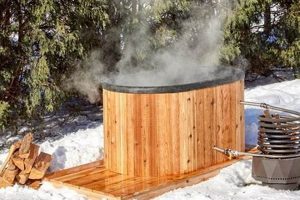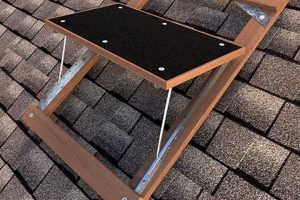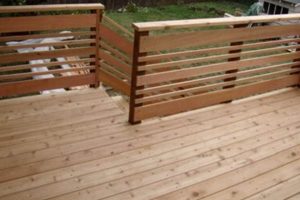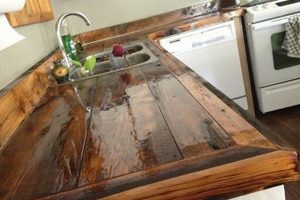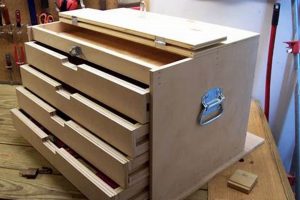The construction of storage solutions from timber, undertaken by the individual, represents a practical application of woodworking skills. This process involves selecting suitable lumber, cutting it to the required dimensions, and assembling the components to create a functional and aesthetically pleasing shelving unit. For example, one might choose pine boards, cut them to specific lengths, and then join them with screws and wood glue to form a set of shelves for a home office.
Such projects offer numerous advantages, including cost savings compared to purchasing pre-made furniture, customization to fit specific spaces and needs, and the satisfaction of creating something oneself. Historically, self-sufficiency in furnishing the home was a necessity; modern motivations extend to creative expression and sustainable practices, utilizing reclaimed wood or minimizing environmental impact.
The subsequent discussion will address key aspects related to this type of endeavor, including material selection, necessary tools, step-by-step construction techniques, and finishing options to ensure a durable and visually appealing outcome.
Essential Considerations for Timber Storage Construction
Successful creation of storage units from timber necessitates meticulous planning and execution. The following guidance offers insights to optimize project outcomes.
Tip 1: Material Selection: Choose lumber based on intended load capacity and aesthetic preferences. Softwoods, such as pine, are suitable for lighter loads, while hardwoods, like oak, offer greater strength and durability.
Tip 2: Accurate Measurements: Precise measurements are crucial. Prior to cutting any timber, verify dimensions multiple times. Errors in measurement can lead to structural instability or visual inconsistencies.
Tip 3: Secure Fastening: Utilize appropriate fasteners, such as screws or nails, designed for woodworking applications. Ensure fasteners are adequately sized and spaced to provide a secure connection between components.
Tip 4: Surface Preparation: Sand all timber surfaces thoroughly before assembly and finishing. A smooth surface enhances the aesthetic appeal and improves the adhesion of finishes.
Tip 5: Appropriate Finish: Select a finish that protects the timber from moisture and wear. Options include varnish, polyurethane, or paint, depending on the desired appearance and level of protection.
Tip 6: Proper Joint Construction: Employ sturdy joinery techniques, such as rabbet joints or dado joints, to enhance the structural integrity of the unit. These joints provide greater surface area for adhesion and increased resistance to stress.
Tip 7: Pre-Drilling: Always pre-drill pilot holes before driving screws into hardwood. This prevents splitting and ensures a secure and flush screw placement.
Adhering to these recommendations facilitates the fabrication of storage solutions that are both functional and visually appealing, providing durable service for years to come.
The ensuing segment will outline the concluding perspectives on the aforementioned subject.
1. Dimensional Accuracy
Dimensional accuracy is a fundamental prerequisite in the construction of timber storage solutions. Deviations from specified measurements can compromise the structural integrity, aesthetic appeal, and overall functionality of the finished product. Achieving and maintaining dimensional precision throughout the fabrication process is therefore of utmost importance.
- Structural Stability
The adherence to exact dimensions ensures that all components fit together as designed, distributing weight evenly and preventing stress points that could lead to failure. An example of this would be shelf supports that are too short, leading to sagging or collapse under load.
- Joint Integrity
Accurate dimensions are crucial for creating strong and reliable joints. For instance, when constructing a dado joint, precise measurements are necessary to ensure a snug fit between the shelf and the side panel, maximizing the surface area for glue adhesion and mechanical fastening.
- Aesthetic Consistency
Dimensional inaccuracies can detract from the visual appeal of the shelving unit. Misaligned edges, uneven spacing, or asymmetrical arrangements are immediately noticeable and can diminish the overall quality of the finished project. Consistent measurements contribute to a polished and professional appearance.
- Installation Compatibility
If the shelving unit is intended to fit within a specific space or between existing structures, dimensional accuracy is paramount. A shelving unit that is too wide or too tall may not fit properly, requiring modifications or even rendering the project unusable. Accurate dimensions ensure a seamless integration into the intended environment.
In summary, dimensional accuracy directly impacts the durability, functionality, and visual appeal of the timber storage solution. Failure to prioritize precision can lead to structural weaknesses, aesthetic flaws, and installation challenges, ultimately diminishing the value and lifespan of the project. Therefore, meticulous attention to detail and adherence to specified dimensions are essential for successful completion.
2. Material Durability
Material durability is a pivotal attribute influencing the longevity and utility of storage solutions constructed from timber. The inherent properties of the chosen lumber dictate the shelving unit’s capacity to withstand applied loads, resist environmental degradation, and maintain structural integrity over time. The selection of durable materials is therefore paramount for ensuring the lasting value and functionality of projects involving the construction of storage systems from timber.
- Load-Bearing Capacity
The maximum weight a shelf can support without deformation or failure is directly related to the species of wood used. Hardwoods, such as oak and maple, exhibit superior strength and resistance to bending compared to softwoods like pine or fir. Selecting an appropriate wood type, considering the intended load, is crucial for preventing sagging or collapse. Exceeding a shelf’s load-bearing capacity can lead to structural damage and potential hazards.
- Resistance to Moisture and Decay
Prolonged exposure to moisture can lead to wood rot and fungal growth, compromising the structural integrity of the shelving unit. Certain wood species, such as cedar and redwood, possess natural resistance to decay, making them suitable for use in humid environments. Applying protective finishes, such as sealants or paints, can further enhance the wood’s resistance to moisture and extend its lifespan.
- Resistance to Wear and Abrasion
The surface of the shelving unit is subject to wear and tear from repeated use, including the abrasion caused by placing and removing objects. Hardwoods offer greater resistance to scratching and denting compared to softwoods, maintaining their aesthetic appeal over time. The application of durable finishes, such as polyurethane, can provide an additional layer of protection against wear and abrasion.
- Dimensional Stability
Changes in temperature and humidity can cause wood to expand and contract, potentially leading to warping or cracking. Certain wood species exhibit greater dimensional stability than others, minimizing these effects. Proper seasoning and drying of the lumber before construction can also improve its dimensional stability. Failure to account for dimensional changes can result in structural damage and aesthetic flaws.
In essence, the durability of materials used significantly influences the performance and longevity of timber-constructed storage solutions. Careful selection of wood species, consideration of environmental factors, and the application of appropriate protective finishes are essential steps in ensuring that the shelving unit provides reliable service and maintains its aesthetic appeal for years to come. Prioritizing durability results in a worthwhile investment, minimizing the need for frequent repairs or replacements.
3. Structural Integrity
In the context of timber storage construction by individuals, structural integrity represents the ability of the shelving unit to withstand applied loads and stresses without deformation or failure. The attainment of structural integrity is a direct consequence of sound design principles, material selection, and construction techniques. For instance, inadequately sized shelf supports, when subjected to excessive weight, may buckle or break, demonstrating a lack of structural integrity. Conversely, a well-designed unit, utilizing appropriate lumber and robust joinery, will maintain its form and functionality under similar conditions, evidencing a high degree of structural integrity.
The absence of structural integrity can manifest in various ways, including sagging shelves, joint separation, and complete collapse. To mitigate these risks, careful consideration must be given to the anticipated load, the properties of the chosen timber, and the method of assembly. A shelf intended for heavy items, such as books or tools, necessitates stronger materials and more secure connections than a shelf designed for lighter objects. Proper spacing of supports, employing techniques like rabbet or dado joints, and utilizing appropriate fasteners such as screws rather than nails, all contribute to enhanced structural stability. Moreover, understanding the grain direction of the wood and its impact on strength is vital for maximizing load-bearing capacity.
Ultimately, structural integrity is not merely a theoretical concept, but a critical element determining the safety and longevity of structures constructed from timber. By adhering to established engineering principles, exercising diligence in material selection and construction, and carefully considering the intended application, individuals can confidently create storage solutions that are both functional and structurally sound. Prioritizing structural integrity ensures the sustainability and reliability of a timber storage unit, minimizing the risk of costly repairs or potential hazards.
4. Aesthetic Harmony
The concept of aesthetic harmony is central to the successful integration of self-constructed timber storage solutions within a given environment. It involves a cohesive blend of the shelving unit’s visual characteristics with the existing dcor, architectural style, and functional needs of the space. Neglecting aesthetic considerations can result in a visually discordant element that detracts from the overall ambiance.
- Material Selection and Finish
The choice of wood species and the application of a suitable finish significantly impact the aesthetic integration of the shelving unit. A natural wood finish may complement a rustic or Scandinavian-inspired interior, while painted surfaces can be used to match or contrast with existing color palettes. The selection of hardware, such as shelf supports or knobs, should also align with the chosen style.
- Form and Proportion
The shape, size, and proportions of the shelving unit must be carefully considered in relation to the dimensions of the space and the objects it will house. A tall, narrow shelving unit may be suitable for a small room with limited floor space, while a wider, lower unit may be more appropriate for a larger room with ample horizontal space. The spacing between shelves should also be tailored to accommodate the items intended for storage.
- Style and Design Coherence
The design of the shelving unit should reflect the overall aesthetic of the room. A modern interior may benefit from clean lines, minimalist details, and the absence of ornamentation, while a more traditional setting may accommodate decorative moldings, intricate carvings, or a distressed finish. Maintaining consistency with the prevailing style enhances the sense of visual unity.
- Contextual Integration
The surrounding elements in proximity to the completed project, such as lighting, art, and furniture, can significantly affect visual appeal. Careful consideration should be taken when arranging the shelves in relation to these surrounding features to complement the design, color or layout that might already be present.
In conclusion, achieving aesthetic harmony in timber storage solutions requires a holistic approach that considers material selection, form, style, and contextual integration. Careful planning and attention to detail will result in a visually pleasing and functional addition to the living space, seamlessly blending with its surroundings and enhancing the overall aesthetic appeal. The success is predicated on the mindful integration of a storage solution as an element of the space as a whole.
5. Efficient Assembly
The expeditious and methodical arrangement of components in timber storage construction directly influences project duration, cost-effectiveness, and the overall quality of the finished product. Suboptimal assembly procedures can lead to increased material waste, structural weaknesses, and extended project timelines. Therefore, optimizing the assembly process is a critical component in successful woodworking.
Efficient assembly in timber shelving creation often begins with comprehensive pre-planning. This includes a detailed schematic outlining component dimensions and joinery methods, ensuring all necessary materials and tools are readily available, and pre-finishing components where appropriate. For example, applying stain or sealant to individual shelves before assembly can streamline the finishing process and minimize the risk of drips or uneven coverage. Real-world examples of efficient assembly include employing jigs for repetitive tasks, such as drilling pilot holes or securing shelf supports, and using clamps strategically to ensure tight and accurate joints. Conversely, neglecting pre-planning, such as failing to verify the squareness of components before joining, can result in cumulative errors that compromise the structural integrity and aesthetic appeal of the completed shelf. Consider a project that involves creating multiple shelves. Failing to set up an effective system for making and installing shelf supports can quickly amplify the necessary time to complete the project.
The principles of efficient assembly extend beyond mere speed. They encompass minimizing material waste, reducing the likelihood of errors, and ensuring the structural integrity of the finished product. Challenges to efficient assembly can include inadequate workspace, insufficient clamping force, or a lack of experience with specific joinery techniques. Understanding the interplay between design, materials, and assembly procedures is crucial for achieving optimal outcomes in these type of projects, promoting a sustainable and rewarding experience for the individual involved.
Frequently Asked Questions
The subsequent section addresses common inquiries pertaining to the design, construction, and maintenance of storage solutions built from timber. The information presented is intended to provide clarity and guidance to individuals undertaking such projects.
Question 1: What wood species are most suitable for shelving, considering both cost and durability?
Pine represents a cost-effective option for shelving. Oak or maple offer enhanced durability for heavy loads, albeit at a higher expense. The selection should align with budget constraints and anticipated load requirements.
Question 2: What tools are essential for constructing timber shelving?
A circular saw, drill, measuring tape, level, and safety glasses are fundamental. Additional tools, such as a sander and clamps, can facilitate a more refined finish and secure assembly.
Question 3: How can one ensure that shelves are level during installation?
A spirit level is indispensable for verifying horizontal alignment. Shims can be employed to correct minor imperfections in the wall surface, ensuring a level installation.
Question 4: What type of finish is recommended to protect wood shelving from moisture?
Polyurethane or varnish provides a durable, water-resistant barrier. Application should adhere to the manufacturer’s instructions, typically involving multiple coats with sanding between applications.
Question 5: How can shelves be securely attached to a wall?
Screws anchored into wall studs provide the most secure attachment. If studs are not accessible, wall anchors designed for heavy loads can be employed, adhering to the weight limitations specified by the manufacturer.
Question 6: What are the best practices for maintaining the appearance and integrity of timber shelving?
Regular dusting and occasional cleaning with a mild soap solution are recommended. Avoid prolonged exposure to direct sunlight or excessive humidity, as these conditions can lead to warping or discoloration.
In summation, the fabrication of storage structures from wood requires careful planning, diligent execution, and an understanding of the materials and techniques involved. Adhering to these principles will contribute to the creation of functional and aesthetically pleasing storage solutions.
The proceeding section will address the topic from a concluding standpoint.
Wood Shelving DIY
This exploration has illuminated the key factors governing the successful implementation of timber storage construction by individuals. Attention to dimensional accuracy, material durability, structural integrity, aesthetic harmony, and efficient assembly are paramount. Moreover, understanding the nuances of material selection, joinery techniques, and finishing processes is critical for producing functional and aesthetically pleasing results. Overlooking these aspects can lead to structural weaknesses, visual inconsistencies, and diminished longevity of the completed unit.
The creation of storage from wood represents more than a mere construction project; it constitutes an investment in both practicality and personal expression. The enduring value of a well-executed endeavor resides not only in its utility but also in its contribution to the organization and aesthetic enhancement of the environment. Individuals are encouraged to approach these projects with diligence and a commitment to quality, recognizing the lasting impact of their efforts on both the space and the objects it contains.


